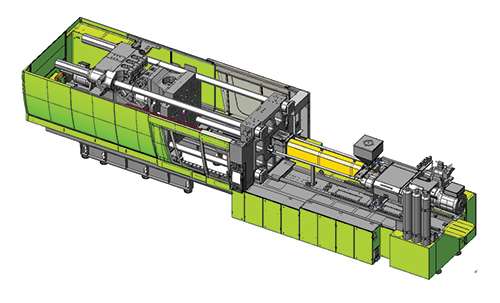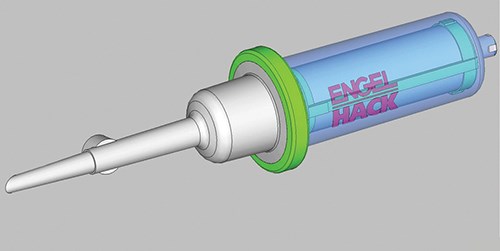Higher Speeds, More Integrated Processes at K Show
Close Up: Injection Molding
“Go faster” and “integrate more functions” look to be the guiding principles of new injection molding developments to be shown by Engel Austria at K 2013 in Dusseldorf this October.
“Go faster” and “integrate more functions” look to be the guiding principles of many new injection molding developments to be shown at K 2013 in Dusseldorf this October. Those will certainly be major emphases of exhibits by Engel Austria (U.S. office in York, Pa.), which were previewed for the global plastics press in June. Engel will present several new electric, hybrid, and hydraulic machines and demonstrate complex integrated processes for automotive, medical, packaging, optical, and electronics. One particular highlight will be at least three demonstrations of adapting high-performance composites to injection molding.
SPEEDY MACHINES
Engel’s new e-speed 650 is a 650-metric ton hybrid with an electric toggle clamp and screw drive and hydraulic injection. This highperformance machine is designed for injection speeds to 1000 mm/sec and less than 2.5-sec clamp dry cycle, allowing for overall cycles of less than 4 sec. A notable feature of this machine is a completely new electric drive solution that uses a flywheel below the clamp as a kinetic-energy storage system. It stores the braking energy from the platen movements and transfers this energy back to the motor when required to re-accelerate clamp motions. This system reportedly uses less energy and lower connected loads, generates less waste heat, and reduces power peaks that would result from high clamping forces applied in short cycles. Engel is thinking of applying this to machines of 400 to 500 m.t.
Another feature is the encapsulated toggle with closed-loop lubrication and special bushings with patented seals. These are said to reduce lubricant consumption by 90% and provide a clean molding area. The e-speed 650 will mold thin-wall tub containers in an 8 + 8 cavity stack mold in less than 4 sec.
Also brand-new is the e-motion 30 TL all-electric tiebarless press of 30 m.t. Aimed at optical and electronic parts, it’s designed for maximum precision and energy efficiency, with low machine weight and compact footprint, plus dry cycles well under 1 sec. Injection speed is up to 800 mm/sec (at 3200 bar pressure) with acceleration greater than 40 m/sec2. These capabilities will be used to mold 60-pin electronic connectors in 16 cavities at K.
The press has a new kind of “intelligent” frame in place of the heavier, bulkier double frame on older e-motion models. The new frame provides very high platen parallelism and uniform distribution of clamp force. The compact clamp has a sealed toggle lever and the servo-electric ejector and mold-height adjustment are integrated into the moving platen. Engel plans to introduce an 80-m.t. model next year and may eventually go as large as 100 m.t.
Another new series is the next-generation duo line of hydraulic two-platen presses (350 to 700 m.t.). They have an improved clamp that is faster, runs on linear guides, and has a lower nozzle center. Also new are the ergonomic safety-gate design unveiled at Engel’s open house last year (see Sept. 2012 issue) and the new CC 300 control. The latter is designed to be operated with one hand and has a highly responsive, 21-in. touchscreen with both task-oriented and component-oriented navigation. It’s available for all new Engel machines and will appear on almost all its presses at the show.
Meanwhile, enhanced speed is claimed for an upgraded line of electric servo-powered injection units. The direct-drive premium versions match hydraulic injection speeds of up to 800 mm/sec (at 2000 bar pressure). This injection unit will be demonstrated in 96-cavity molding of needle holders for insulin pens on an e-motion 440 T electric toggle machine. The cores are just 0.3 mm thick and the trick is to prevent deflection while injecting at up to 500 mm/sec for cycles around 5 sec.
INTEGRATED PROCESSES
At K, Engel will show off capabilities for automating complex processes with multiple functions performed in a single machine and mold. For medical molders, Engel will demonstrate three-material-plus-insert molding of a drip chamber for blood transfusions. The process uses an e-victory 310 combi tiebarless hybrid with three electric injection units, servo-hydraulic ecodrive, and cleanroom design. The body of the drip chamber is molded of ABS and TPE in one step; the filter is inserted by an Engel easix jointed-arm robot; the servo-electric index plate rotates the mold so that the filter can be joined to the body by overmolding with PP; the robot demolds parts for seal inspection.
For automotive, Engel will show a new method of multi-component, soft-touch molding of interior components. The new Varysoft process developed by Georg Kaufmann Formenbau in Switzerland will be used to mold dashboards for Hyundai Kia Automotive Group. A decorative, grained TPO film is preheated and preformed in one station of the automated cell while the thermoplastic substrate is molded in ABS/PC with the MuCell microcellular process from Trexel, Wilmington, Mass.
The TPO film is then transferred to the mold on a rotating table, where the film is placed in the same cavity as the substrate. After the mold closes, PUR foam is injected between the film and substrate, using a system from Hennecke of Germany (U.S. office in Pittsburgh). The cell uses an Engel viper 40 double robot and an easix multi-axis robot for trimming the excess film with an ultrasonic knife.
Automotive is the main—but not the only—target for new methods of injection molding “hybrid” structural composites with continuous fibers in preimpregnated organic sheets and tapes. One of three demonstrations at K will use a vertical press with a six-axis robot and infrared oven to mold an award-winning brake pedal for ZF-Friedrichshafen (see Nov. 2012 issue). The system produces a finished product that needs no trimming.
Another automotive composite demonstration will use the new v-duo vertical two-platen hydraulic machine with ecodrive, introduced at last year’s open house. A 700-m.t. model will produce latch covers for the KTM X-Bow GT sports car using carbon-fiber fabric in the skin and glass fiber in the core. The liquid reactive molding process, which Engel calls HP (high-pressure) RTM, will use a new “snap-cure” PUR resin from BASF Polyurethanes (U.S. office in Wyandotte, Mich.) and a Hennecke metering system. KTM Technologies GmbH in Austria designed the part and performed RTM mold-filling simulation.
A third composite demo at K is aimed at teletronics rather than automotive. Preformed carbon-fiber organic sheets will be overmolded with PC/ABS to make cases for mobile electronic devices (tablet PC, smartphone, or e-book reader) on a new Engel e-mac 170-m.t. all-electric press (introduced at last year’s open house). Roctool variothermal (hot/cold cycling) molds will be used to preform the sheets and overmold them with a high-gloss “piano-black” finish. (Roctool’s U.S. office is in Atlanta). The automated cell will also demonstrate inline vacuum metallization of parts for EMI shielding.
One of Engel’s new e-duo hybrid two-platen machines (introduced at last year’s open house) will mold beverage crates with a combination of gas assist and in-mold labeling. The 700-m.t. machine has electric servos on all axes except the ecodrive-powered clamping cylinders and will use a mold from Haidlmair of Austria (see last month’s Starting Up).
Two machine demos will target technical molding. One uses a 110-m.t. e-motion T electric toggle press to to produce acrylic auto headlamp lenses by a novel three-layer process. This 30-mm-thick part is molded in two steps to save time and reduce sinks. First, the core is molded and demolded while the center is still molten. After cooling outside the mold, it is returned to the mold and overmolded with thinner layers of the same material on both sides. The result is a 440-sec cycle instead of 1550 sec for a single-layer molding. The process requires just one injection unit.
Engel also will debut liquid silicone rubber (LSR) molding with its new, patented iQ weight-control software (introduced at last year’s open house). An e-victory 120 combi press with two electric injection units will overmold LSR onto thermoplastic to produce flow-sensor housings with integral seals. The iQ control continually analyzes the injection-pressure profile vs. screw position for real-time correction of injection speed and switchover point to accommodate changes in material viscosity.
Finally, Engel will show its newest and largest linear robot, the viper 120, in action at K. Introduced last fall at the Fakuma show in Germany, this unit can carry 120 kg (264 lb) and has a demolding stroke of 3000 mm and reach of 3550 mm. Also new is the C70 compact handheld teach pad with 7-in. high-definition display. It weighs only 850 g for less operator fatigue and is compatible with the new CC 300 machine control.
RELATED CONTENT
-
A Conversation With Will Wallace of SAT Plating
SAT Plating general manager Will Wallace talks to Products Finishing about his company’s surface activation technology, plating on composites, and what the changing manufacturing landscape might mean for platers.
-
Proper Testing of a Powder Coat Finish
Manufacturer shows how it performs extensive tests on powder coated medical carts.
-
Cleaning, Pretreatment to Meet Medical Specs ISO 13485 or FDA 21 CFR820
Maximilian Kessler from SurTec explains new practices for industrial parts cleaning, metal pretreatment and decorative electroplating in the medical device industry.


















